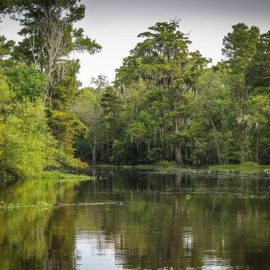
The Nature Conservancy just bought 3,700 acres of land in the Atchafalaya Basin.
The Nature Conservancy has bought 3,700 acres of land in the Atchafalaya Basin, a huge expansion that increases its holdings in the largest U.S. river swamp by 70 percent. The land appraised for $6.8 million, but The Dow Chemical Co. sold it for $1 million. “I think they’re very interested in sponsoring conservation, and they support us as one of our partners.” said Karen Gautreaux, The Nature Conservancy’s Louisiana director. Dow, which operates five plants and employs or contracts more than 6,000 workers in Louisiana, had owned the land for 75 years.
nola.com
The Nature Conservancy is a world wide group that seeks to conserve the land. They now have 70% of the Atchafalaya Basin.
The Nature Conservancy is a global environmental nonprofit focused on land and water, making the Atchafalaya Basin – home to more than 300 species of wildlife and more than 100 species of fish and shellfish – an attraction. It first acquired land in the basin with 5,300 acres in 2015 and now owns 9,000 there. “We want to actively participate and demonstrate how other landowners might implement projects around restoring the basin ecosystem, develop some of the science and also engage the community,” Gautreaux said. With its original acquisition, the nonprofit set up a conservation center with overnight accommodations in the basin to let scientists and students study the environment basin without interruption. Since then, they’ve noticed a rising trend of hypoxia, or dead zones, in the water. A dead zone is an area where the water looks darker than its surroundings, because of a lack of oxygen. Dead zones can move across water or remain stationary, killing fish and shellfish. “Water quality is the main part of the restoration,” said Joseph Baustian, a wetlands ecologist for The Nature Conservancy. “If you get the water flowing through there right and you get the oxygen conditions good, everything else falls into place.”
It appears that the work on better water flow is working.
Fishers in the basin have started venturing further downstream to catch crawfish, presumably because of better water quality there. So the Nature Conservancy hosted students of astacology, the study of crawfish, from Nicholls State University to research water quality and crawfish populations. “They can show quantitatively that when you have poor water quality, you have lower crawfish populations,” Baustian said. “They’re smaller, less numerous, and they’re actually unhealthier.” Plant life in the basin also is affected by poor water quality and the lack of water flow. Some of the basin’s channels and bayous have dried up, leaving cypress trees on dry land. And inadequate nutrients make for vulnerable roots, threatening trees’ prospects for weathering bad storms. These issues are caused in part by river dredging. The Atchafalaya river has been dredged to allow ships to sail through Port Allen. But, this causes the water to flow faster and not deposit as much sediment in the basin.
There are other causes, and some are from earlier efforts to control the water flow.
The Old River Control Structures also exacerbates the issue of water not flowing into the basin’s floodplains. Because the structures divert 30% of the Mississippi river’s flow into the Atchafalaya, sediment has rapidly deposited further upstream than normal. This makes it harder for water to flow into the floodplains downstream. To fix this water quality issue, The Nature Conservancy is working with state government to dredge basin waterways that have dried up over time. “Generally we are putting drains so the water will come in where it used to and be able to get out and not pond, to try to restore that north-south hydrology,” Gautreaux said. The Nature Conservancy has spent the past five years researching and understanding the science of the basin but has not completed its restoration plan. “We’re building the science,” Gautreaux said. “We’re going to monitor the system and hopefully demonstrate an option to improve the health of the system.”
Hopefully the Nature Conservancy will find the right balance and the basin will come back to life.

